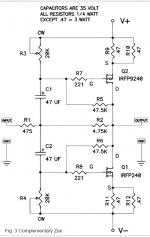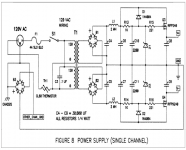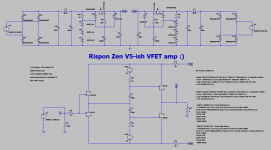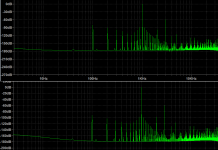yes, but - in case of "1" modulation is referenced to rails, so lesser influence that way
as you drew it, biasing is still referenced to rails, while modulation point is , say, virtual ground
whatever is happening with rails (ripple) will transfer to gates simply bouncing from virtual gnd ......... rail is moving source, while gate being welded to virtual gnd....... that's the same as ripple is moving gate while source being welded to virtual gnd
as you drew it, biasing is still referenced to rails, while modulation point is , say, virtual ground
whatever is happening with rails (ripple) will transfer to gates simply bouncing from virtual gnd ......... rail is moving source, while gate being welded to virtual gnd....... that's the same as ripple is moving gate while source being welded to virtual gnd
oh yeah
being there, done that ........ and will do again
just when I thought that I invented something ....... I see that I didn't and it's not even good at all

being there, done that ........ and will do again
just when I thought that I invented something ....... I see that I didn't and it's not even good at all

I sneaked into VFETs part 2 article to see how Papa did it, but this is a common drain mode, so no voltage gain.
Trying to find out how to have a common source with no transformer and no rails ripple at the output. Tough.
Trying to find out how to have a common source with no transformer and no rails ripple at the output. Tough.
Last edited:
you can always make something F5-ish, with auxiliary rails

ZM Yelling:
WHAT"S WRONG WITH XFORMER, BOY!!!!!?????


ZM Yelling:
WHAT"S WRONG WITH XFORMER, BOY!!!!!?????

I can see that the amp from part 2 is very much like F5 (+cascoded input) + VFET buffer, but... these are 3 stages and I am crazy about minimalistic approaches.
Maybe I should look for inspirations in Zen projects... 🙂
Maybe I should look for inspirations in Zen projects... 🙂
CSX2 is not follower
as Pa said, and your own sim is confirming that , two iterations are same regarding gain, so neither one is common drain
his own words ( even if I learned with time to check everything, him sometimes being clumsy, sometimes deliberately making traps for brainless Greedy Boyz), article "art_sony_vfet_pt1", p8/13:
as Pa said, and your own sim is confirming that , two iterations are same regarding gain, so neither one is common drain
his own words ( even if I learned with time to check everything, him sometimes being clumsy, sometimes deliberately making traps for brainless Greedy Boyz), article "art_sony_vfet_pt1", p8/13:
Here you see the arrangement of the output devices inverted. They may look like Common
Drain connections (followers) but they are not, since the drive voltages provided by the
transformer secondaries are floating – they are still Common Source amplifiers.
The performance for this amplifier is identical except the source providing the input signal will
be driving not only the capacitance of the SIT Gates but also the transformer's internal
capacitance. The result is that a 25 ohm source is required to make a 100 Khz bandwidth
figure. However there is an advantage, which is that it can be easily constructed without the
necessity of separate bias supplies.
I didn'tsay CSX2 is a follower, but looks very much alike.
I was reffering to the amp output in this article:
https://www.firstwatt.com/pdf/art_sony_vfet_pt2.pdf
I was reffering to the amp output in this article:
https://www.firstwatt.com/pdf/art_sony_vfet_pt2.pdf
WHAT"S WRONG WITH XFORMER, BOY!!!!!?????

They are like terrorists, there are no good ones 😛
I didn'tsay CSX2 is a follower, but looks very much alike.
I was reffering to the amp output in this article:
https://www.firstwatt.com/pdf/art_sony_vfet_pt2.pdf
agree on that
you was slowly typing, I was one reading fast
🙂
They are like terrorists, there are no good ones 😛
ok, what's enough, that's enough
you're banned

you're banned
Taking the advantage that my account is not blocked yet 😛 I would like to say that looking at Zen V5:

it came to me that my idea of removing the transformer is not bad at all.
I have simulated the proposed by Mr. Pass PSU for Zen V5:

And got 100Hz ripple at -109dBFS which seems to be pretty ok to me (at 1W).


well... I think it will be still more like CSX. I think with the green light from Papa back from 2005 when he published Zen V5. I hope I am not missing anything here as I would like to invest some time in building this amp, designing PCBs, purchasing chassis - probably 4U (40cm deep) chassis (3U might too small during the hot summers). Maybe I will add some extra filtering... but actually -109dBFS on the power amp output is nothing.
- Home
- Amplifiers
- Pass Labs
- First Watt CSX2 simulation
